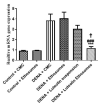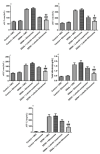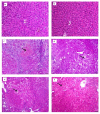Design and Optimization of Orally Administered Luteolin Nanoethosomes to Enhance Its Anti-Tumor Activity against Hepatocellular Carcinoma
- PMID: 34063274
- PMCID: PMC8147467
- DOI: 10.3390/pharmaceutics13050648
Design and Optimization of Orally Administered Luteolin Nanoethosomes to Enhance Its Anti-Tumor Activity against Hepatocellular Carcinoma
Abstract
Luteolin (LUT) is a natural flavonoid with low oral bioavailability with restricted clinical applications due to its low solubility. LUT shows significant anti-tumor activity in many cancer cells, including hepatocellular carcinoma (HCC). The most recent trend in pharmaceutical innovations is the application of phospholipid vesicles to improve the solubility of such hydrophobic drugs. Ethosomes are one of the most powerful phospholipid vesicles used to achieve that that target. In this study, LUT-loaded ethosomal nanoparticles (LUT-ENPs) were prepared by the cold method. Full factorial design and response surface methodology were used to analyze and optimize the selected formulation variables. Drug entrapment efficiency, vesicle size, zeta potential, Fourier transform infra-red spectroscopy, scanning electron microscopy, and cumulative percent drug released was estimated. The selected LUT-ENPs were subjected to further investigations as estimation of hepatic gene expression levels of GPC3, liver biomarkers, and oxidative stress biomarkers. The prepared LUT-ENPs were semi-spherical in shape with high entrapment efficiency. The prepared LUT-ENPs have a small particle size with high zeta potential values. The in vitro liver biomarkers assay revealed a significant decrease in the hepatic tissue nitric oxide (NO), malondialdehyde (MDA) content, and the expression of the GPC3 gene. Results showed a high increase in the hepatic tissue levels of glutathione (GSH) and superoxide dismutase (SOD). Histopathological examination showed a small number of hepatic adenomas and a significant decrease of neoplastic hepatic lesions after treatment with LUT-ENPs. Our results firmly suggest the distinctive anti-proliferative activity of LUT-ENPs as an oral drug delivery system for the treatment of HCC.
Keywords: ethosomes; hepatocellular carcinoma; luteolin; nano-sized vesicles; nanoparticle; oxidative stress biomarkers.
Conflict of interest statement
The authors declare no conflict of interest.
Figures










Similar articles
-
Luteolin-loaded exosomes derived from bone marrow mesenchymal stem cells: a promising therapy for liver fibrosis.Drug Deliv. 2022 Dec;29(1):3270-3280. doi: 10.1080/10717544.2022.2142700. Drug Deliv. 2022. PMID: 36330597 Free PMC article.
-
Luteolin-Loaded Nanoparticles for the Treatment of Melanoma.Int J Nanomedicine. 2023 Apr 20;18:2053-2068. doi: 10.2147/IJN.S400329. eCollection 2023. Int J Nanomedicine. 2023. PMID: 37101838 Free PMC article.
-
Combined Hydroxyethyl Starch Luteolin Nanocrystals for Effective Anti-Hyperuricemia Effect in Mice Model.Int J Nanomedicine. 2024 Jun 4;19:5139-5156. doi: 10.2147/IJN.S464948. eCollection 2024. Int J Nanomedicine. 2024. PMID: 38859954 Free PMC article.
-
The Recent Development of Luteolin-loaded Nanocarrier in Targeting Cancer.Curr Pharm Des. 2024;30(27):2129-2141. doi: 10.2174/0113816128313713240628063301. Curr Pharm Des. 2024. PMID: 38963114 Review.
-
Potential toxicity of engineered nanoparticles in mammalian germ cells and developing embryos: treatment strategies and anticipated applications of nanoparticles in gene delivery.Hum Reprod Update. 2016 Sep;22(5):588-619. doi: 10.1093/humupd/dmw020. Epub 2016 Jul 6. Hum Reprod Update. 2016. PMID: 27385359 Review.
Cited by
-
Tolmetin Sodium Fast Dissolving Tablets for Rheumatoid Arthritis Treatment: Preparation and Optimization Using Box-Behnken Design and Response Surface Methodology.Pharmaceutics. 2022 Apr 18;14(4):880. doi: 10.3390/pharmaceutics14040880. Pharmaceutics. 2022. PMID: 35456714 Free PMC article.
-
Lipid-Based Nanovesicular Drug Delivery Systems.Nanomaterials (Basel). 2021 Dec 14;11(12):3391. doi: 10.3390/nano11123391. Nanomaterials (Basel). 2021. PMID: 34947740 Free PMC article. Review.
-
Tailoring of Rosuvastatin Calcium and Atenolol Bilayer Tablets for the Management of Hyperlipidemia Associated with Hypertension: A Preclinical Study.Pharmaceutics. 2022 Aug 4;14(8):1629. doi: 10.3390/pharmaceutics14081629. Pharmaceutics. 2022. PMID: 36015255 Free PMC article.
-
Application of nanotechnology in the treatment of hepatocellular carcinoma.Front Pharmacol. 2024 Nov 29;15:1438819. doi: 10.3389/fphar.2024.1438819. eCollection 2024. Front Pharmacol. 2024. PMID: 39679376 Free PMC article. Review.
-
Integrating Network Pharmacology and Bioinformatics to Explore the Effects of Dangshen (Codonopsis pilosula) Against Hepatocellular Carcinoma: Validation Based on the Active Compound Luteolin.Drug Des Devel Ther. 2023 Mar 1;17:659-673. doi: 10.2147/DDDT.S386941. eCollection 2023. Drug Des Devel Ther. 2023. PMID: 36883114 Free PMC article.
References
-
- Elsayed M.M., Mostafa M.E., Alaaeldin E., Sarhan H.A., Shaykoon M.S., Allam S., Ahmed A.R., Elsadek B.E. Design and characterisation of novel Sorafenib-loaded carbon nanotubes with distinct tumour-suppressive activity in hepatocellular carcinoma. Int. J. Nanomed. 2019;14:8445. doi: 10.2147/IJN.S223920. - DOI - PMC - PubMed
-
- Refaat H., Naguib Y.W., Elsayed M., Sarhan H.A., Alaaeldin E. Modified spraying technique and response surface methodology for the preparation and optimization of propolis liposomes of enhanced anti-proliferative activity against human melanoma cell line A375. Pharmaceutics. 2019;11:558. doi: 10.3390/pharmaceutics11110558. - DOI - PMC - PubMed
-
- Saddik M.S., Elsayed M., Abdelkader M.S.A., El-Mokhtar M.A., Abdel-Aleem J.A., Abu-Dief A.M., Al-Hakkani M.F., Farghaly H.S., Abou-Taleb H.A. Novel green biosynthesis of 5-fluorouracil chromium nanoparticles using harpullia pendula extract for treatment of colorectal cancer. Pharmaceutics. 2021;13:226. doi: 10.3390/pharmaceutics13020226. - DOI - PMC - PubMed
LinkOut - more resources
Full Text Sources

